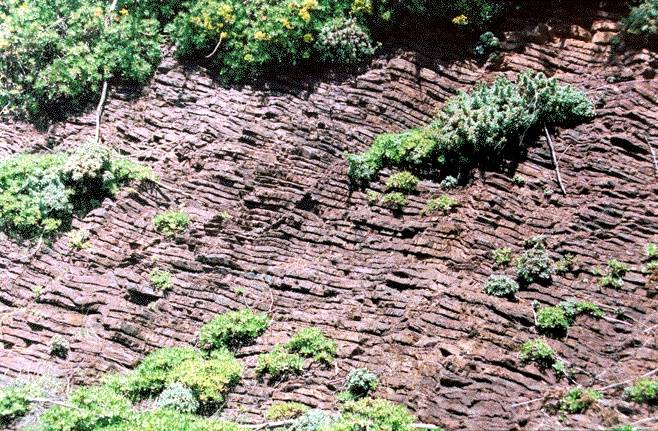Serpentine Grasslands and Maritime Chaparral
"Developed" hillside provides a clear look at San Francisco's common chert underpinning. After being carved away it becomes ripe for invasion, in this picture being overrun by the exotic French Broom (with the yellow blossoms). Photo: Chris Carlsson
Serpentinite originates in the Earth's mantle. Temperature and pressure in active tectonic zones--areas where continental plates are colliding--work in tandem to alter rocks from ancient oceanic crust. Fractured and warped by tectonic forces, serpentinite eventually reaches the surface in patches, squeezing its way through the surrounding bedrock. Two active faults, the San Andreas and the Hayward, account for the patchy pattern of serpentine outcrops in the Bay Area.
Serpentine outcrops--composed of serpentinite, California's state mineral--were once fairly common in San Francisco, stretching in a band from Hunter's Point and Potrero Hill to the Presidio. You can still see the green-tinted rock underneath the Old Mint at Market and Duboce, but only at the Presidio do serpentine outcrops still support native vegetation.
Serpentine plant communities in the Presidio escaped development, but not unscathed. Mediterranean annual grasses have come to dominate most California grasslands, but chemical properties of serpentine soils have enabled serpentine grasslands to resist complete conversion to annual grasslands. Serpentinite weathers into a thin rocky soil containing high levels of heavy metals such as magnesium, nickel, and chromium--in high enough concentrations these can be toxic to plants. Serpentine soil is also characterized by low levels of calcium, nitrogen, and other essential elements.
Many plants have a very difficult time growing in such harsh serpentine soils, while some have evolved special adaptations for dealing with the toxic conditions. In fact, ten percent of California's endemic flora is restricted to serpentine soils, even though such soils cover only one percent of California. Several plant species evolved right here in San Francisco. The Franciscan manzanita (Arctostaphylos hookeri ssp. franciscana), the Presidio manzanita (Arctostaphylos hookeri ssp. ravenii), and the Presidio clarkia (Clarkia franciscana) are San Francisco endemics, that is, species restricted to a particular place or region.
As San Francisco grew, its serpentine outcrops were covered in buildings and homes. At least one species--the Franciscan manzanita--went extinct. It was last seen in the wild in the early 1940s at the Laurel Hill Cemetery and the Masonic Cemetery. The closely-related Presidio manzanita is just barely hanging on, down to the very last wild individual of its kind. The Presidio clarkia is faring a little bit better, but its habitat--and hence its future--has deteriorated to such an extent that it is listed as endangered under both the state and federal Endangered Species Acts.
Remnant serpentine grasslands are among the most endangered ecosystems in the Bay Area. Occasional and patchy even in prehistoric San Francisco, only a few acres of these communities remain in the city. Surrounded by inhospitable habitat and isolated from similar communities, these areas are especially vulnerable to local extinctions. The Bay checkerspot butterfly (Euphydryas editha bayensis) was once relatively common in San Francisco, but is now found only in larger serpentine grasslands south of the city.
Disturbance associated with intensive human use has dramatically affected the grasslands. Rock quarrying and road building have directly reduced their extent and fragmented them into small isolated patches. Proliferation of unofficial trails recently caused the Presidio's largest population of the threatened serpentine-dependent Marin dwarf flax (Hesperolinon congestum) to plummet from several thousand to a few hundred in just a few years. Domestic pets cause additional disturbance by digging for gophers and by depositing nitrogen-rich feces, allowing even more non-native annual grasses to become established.
--Pete Holloran

